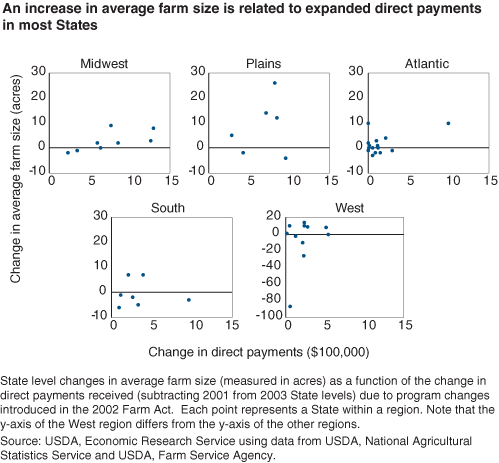Direct Payments Can Influence Farmers’ Production Decisions
- by Erik O'Donoghue
- 9/1/2010
Each year, U.S. farmers whose crops qualify them for Government payments receive roughly $5 billion in direct payments from the Federal Government. Originally introduced as Production Flexibility Contract (PFC) payments in the 1996 Farm Act, these direct payments are based on historic acreage and yields of selected field crops. Because they do not depend on current production or market conditions, PFC payments theoretically would not influence farmers’ planting decisions.
However, researchers have since identified multiple avenues through which such payments could influence agricultural production, including providing easier access to capital markets, changing farmers’ risk preferences, or affecting land values, labor markets, and/or farmers’ expectations about future payments. Changes in farmers’ production decisions, in turn, could affect the welfare of domestic and international producers and consumers if agricultural commodity markets change as a result.
To explore this issue, ERS researchers compared operators’ decisions from before and after the 2002 Farm Act, which introduced changes to the PFC program. The Act renamed the payments “direct payments” and expanded the old program to include peanuts and oilseeds (particularly soybeans, which accounted for nearly half of the increase in direct payments between 2002 and 2003). In addition, recipients were given the option to update their program acreage to more accurately reflect current cropping practices.
Using USDA’s Agricultural Resource Management Survey, ERS researchers grouped farmers into cohorts (based on farm type and location) to allow for valid comparisons over time. By examining production decisions for 2 years before and after the 2002 Act and controlling for various influences, including output and input prices, farm size, and farmers’ net wealth, researchers could attribute changes in production decisions to the new policy environment.
Findings show that increases in direct payments led recipients to expand the size of their farms by an average of 44 to 78 acres (a 9- to 16-percent increase), depending on how the cohorts were constructed. While this positive relationship appears in almost all regions, it is particularly evident in the Midwest region. These results suggest that direct payments caused significant changes in producer behavior at the individual level. However, whether these payments distorted domestic or international markets remains unclear. During the study period of 2000 to 2004, more than 8 percent of all U.S. corn, soybean, wheat, cotton, peanut, and tobacco farms exited the marketplace. The payments may have facilitated ongoing consolidation of production if direct payments allowed the remaining farmers to increase the size of their operations by incorporating this land (rather than increasing total production). While the payments appear to influence individual farmer behavior, overall market outcomes may be unaffected.
This article is drawn from:
- “Do Direct Payments Distort Producers’ Decisions? An Examination of the Farm Security and Rural Investment Act of 2002,” by Erik J. O’Donoghue and James B. Whitaker. (2010). Applied Economic Perspectives and Policy, Vol. 32, No. 1, Spring.


